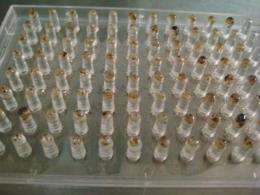Researchers develop new method of cleaning toxins from the oilsands

Alberta's oilsands have water challenges. Oilsands development uses a vast amount of water and even though it's recycled multiple times, the recycling concentrates the toxins and metals leftover from extracting and upgrading the bitumen, resulting in tailings ponds that are both a lightening rod for controversy and a significant risk to the environment. A research project underway between biologists at the University of Calgary and engineers at the University of Alberta to help resolve the water issue is making rapid progress toward that goal.
Two years into the research, both groups are excited about their progress. A paper into the first round of research will be published in the January edition of FEMS Microbial Ecology.
Much of the research into tailings remediation has focused on microbes and their ability to settle the tailings sludge and clean the water. This NSERC-funded research is focused on a certain kind of bacterial growth called biofilms. Biofilms are everywhere in our environment, including in the plaque on our teeth and they can be very resilient, says Dr. Raymond Turner, a professor in the Department of Biological Sciences at the University of Calgary.
"We've isolated biofilms that are indigenous to the oilsands environment and are highly tolerant to the stress associated with toxins and metals found in tailings water. Those consortia of biofilms are able to, slowly, detoxify the water," says Turner, who co-leads the project with Dr. Howard Ceri, biological sciences professor at the University of Calgary.
A sample of sediment, or sludge, was taken from a tailings pond in the summer of 2009. MSc candidate and paper co-author Susanne Golby was able to successfully cultivate biofilms from the sample under a variety of different conditions.
"It was really exciting when we found that multiple different species could be recovered within one biofilm. By altering the growth conditions, and exposing the biofilms to different stressors, we could select for or against certain species and we began to learn how we could manipulate the biofilms to get the metabolic activities and characteristics we were looking for."
With the proof of principle in place, Turner and his team is now actively growing biofilms on the support material to test in bioreactors, which are being developed by professors and their graduate students in the Department of Civil and Environmental Engineering at University of Alberta.
The ultimate goal, says Turner, is to develop tailings water treatment plants for all the oilsands operations. "The plant would take all tailings water, completely clean it, and return it to the river system. Just like wastewater in Calgary is cleaned and returned to the Bow River."
Provided by University of Calgary














